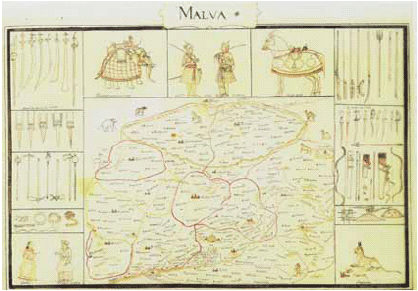| Surveying | |
Indian prelude to British cadastral and revenue maps
|
||||
| Raja Todarmal was the minister for revenue in the court of Akbar. Building upon the foundations laid by Sher Shah, Todarmal introduced a system of land reforms, the essence of which was an assessment of the land revenue according to the extent of cultivation, the nature of the soil and the quality of the crops. He set up a scheme of laborious measurement, analysis of possibilities and calculation of prospects. The actual demand was adjusted to meet seasonal price and cultivated area variation. Though at times it broke down and was deployed unevenly within the Moghal Empire, it is the underlying basis of the later day revenue systems. The British became the pupils of the Moghal School, being impressed by the range and thoroughness of the system. In spite of false starts and harsh application in the early days, the British could build up a rural administration not only stable but generally equable and equitable.
The Moghal revenue administration demanded precise measurement of productive cultivated land. A number of units came into force. The llahi gaz, a measure of length and standard gauge was used throughout the Moghal Hindustan in long, middling and short forms, each divided into 24 equal parts and each was called a tussuj, equal to 8,7 or 6 barley-corns. The gaz is equal to two spans of 16 gerths each. There were however variations of the length of the gaz even with Moghal India. The bigha is a land measure of 60*60 gaz. A larger unit was the Kos or Karoh, each consistion of 50 llahi gaz or 400 poles, each of length 12.5 gaz. Thus the kos is a length of 5000 gaz. Abul Fazal states that there were significant variations in the length of the kos in different parts of Moghal India. Raja Todarmal was not however the first to generate a revenue system available in all parts of the empire. Much before him, others have had their notable contributions in this regard in different parts of the country. Kautilya’sArthasastra in the Maurya period was one of the earliest to recognize the relevance of land revenue collection from productive farmlands, in villages with settled population of farmers. The Sukra neeti talks of recognition of revenue estimation from cultivated land according to the fact the land is watered by tanks and lakes, by rivers, by wells and sluices apart from dry farming rainfed areas and the nature and number of crops raised in each parcel. An area of significant development of land information for revenue levies is the Tamilnadu agricultural plains. Though Tamil Nadu has beenoccupied at least since the Neolithic age, early settlements of a shifting character were confi ned to the Kurinji or the hills, gradually down-migrating over centuries to the pastoral foothills or mullai by early Christian era. The further occupation of the river plains and the agriculturally fertile deltas led to sedentary population living amidst riverine farm country. Peasant technology led to use of irrigation through different methods and raising of more than one seasonal crop, apart from tree crops. By mid-10th century, with the advet of the later Cholas, specially Raja Raja productive cultivated land constituted a major source of land revenue for the upkeep of the Chola mandalam. Farm villages came to be precisely defined. As per Chola stone inscriptions and numerous copper plates, a village came to be defined as comprising wet lands, dry lands, ur (cultivators), village site, houses, houses house gardens, manram (meeting place), wastelands for grazing cattle, tanks, cow pens, hedges, forest land, barren lands, brackish lands, streams, channels, rivers, Arabic land near rivers, pits of water, trees. (Subbarayalu) Villages were further grouped as brahmadeyas (Brahmin villages), Vellala villages (farmer villages), taniyur, devadana villages (gifted to Brahmins, temples and those who have rendered recognized state service. Hundreds of descriptions are noted in inscriptions and copper plates of temple donations (of land or land income), endorsed by the state that give precise locations and measures of lands donated, together with their boundary limits. Though verbal, these descriptions of individual plots of land give indication of an early system of cadastral plans. The land measurement units used in Tamil Nadu however differ from those prevalent in the northern plains. The smallest unit used is a viral (fi nger). 12 virals (9”) make a chaan and 24 virals (18”) make a muzham (cubit). A muzhakol (cubit pole) is 9 or 12 ft long and is used as a measuring rod. The smallest land plot is a 12 ft. square called a Kuzhi. Hundred Kuzhis make a Kaani and fi ve Kaanis is a veil, somewhat similar to the northern bigha. Land as small in extent as 1/52.4288 millions of a veli was measured in the productive Cauvery valley in the Chola period (equal to 1/500000th of a square foot, (Burton Stein). While the basic cultivated field plot was a veli, and a village was defi ned as stated in the above para and comprised many farm plots, that were as far as possible rectangular of square in shape, except where natural features like water channels formed the bounding limits. The basic agrarian unit was nadu comprising many villages. With land reclamation in the newer delta fringes, new nadus came into existence, though of lower fertility than the core Chola heartland. The Chola system of land management went on a decline post-fourteenth century, (Heitzman) but the basic framework and structure remained intact to become the basis of the later British cadastral and revenue surveys. In the well-watered Travancore and Malabar, a compact village was not the agricultural unit. The tarawad of the Namboodri and Nair constituted the land unit, with lzhavas and Tiyars as the main farm labour. The hills and slopes terrain with a network of backwaters and lagoons lent to a hierarchy of land rights of the janmis that were multilayered. The land was held on lesser forms of tenure, and sharecropping was quite common. Land was devoted not only to rice farming but also a variety of tree crops. The traditional system did not undergo any major change with the coming of the Islam, nor did it get disturbed by the arrival of the Portuguese and the Dutch. However, a gradual break-up of the larger tarawads did materialize. Temple lands and garden lands were given patta by the Travancore mahraja since mid eighteenth century. Actual survey by traverses or baseline and offset system did not materialize till independence. A somewhat similar land ownership system evolved in the Lakshadweep with the government pandaram. Lands not being held in private property, but it is the trees that were owned. The middle class Vellala identification of the Tamil country finds its reflection in the Okkaliga and Lingayat land ownership in larger plots in the semi-dry Mysore Maidan. |
||||
Pages: 1 2















 (2 votes, average: 3.50 out of 5)
(2 votes, average: 3.50 out of 5)




